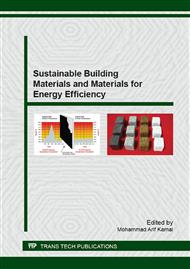p.1
p.13
p.21
p.29
p.38
p.51
p.71
p.82
Application of Polymer-Mortar Composites as a Sustainable Building Material
Abstract:
In a number of countries, important research projects are nowadays carried out and are mainly devoted to developing original approaches to sustainability in order to improve the lifetime of reinforced concrete structures. This paper describes an innovative use of plastic bottle waste as cement-substitution within composite materials for preventing chemical attacks, energy efficiency in buildings or repairing various reinforced concrete structures. So, experiments were accomplished on polymer-mortar composite materials where the cement was partially replaced by various volume fractions of waste polyethylene terephthalate (PET) particles (0%, 6%, 12% and 17%). The specimens were tested by destructive and non-destructive testing and for chemical resistance to acid solutions at different concentrations. From this study, it was found that the PET-modified mortars exposed to aggressive environments showed better resistance to chemical attack than unmodified one without substantially affecting the mechanical strength in tap water and UPV values decrease as the proportion of PET waste in the mix increases. The addition of PET to the modified mortars, means reducing the penetration of aggressive agents. The formations which appear such as different calcium salts were determined by TG/dTG analysis. So, these composite materials are often used as low-cost materials for energy efficiency in buildings, preventing chemical attacks or repairing various reinforced concrete structures exposed to aggressive environments where high resistance to acid is required and to both reduce sound intensity and dampen vibrations.
Info:
Periodical:
Pages:
21-28
Citation:
Online since:
July 2015
Authors:
Price:
Сopyright:
© 2015 Trans Tech Publications Ltd. All Rights Reserved
Share:
Citation:


